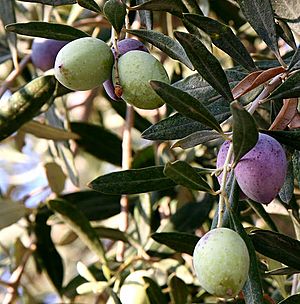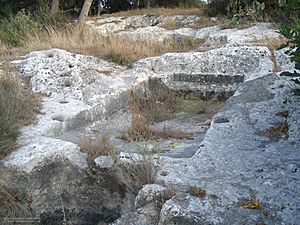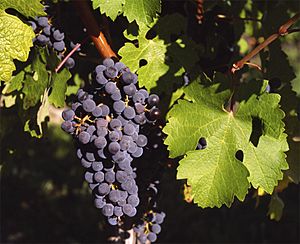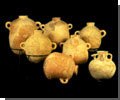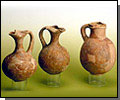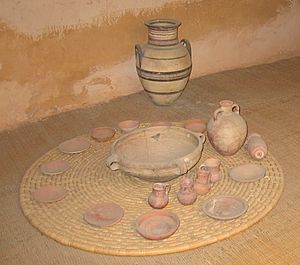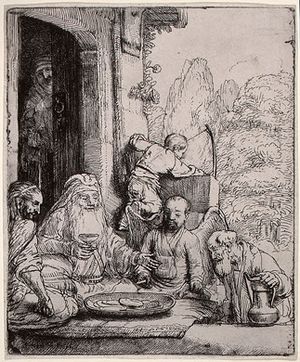Ancient Israelite cuisine facts for kids
Ancient Israelite cuisine was the way people in ancient Israel cooked and ate. This was from the time the Israelites arrived in the Land of Israel during the Late Bronze Age until Jewish people were largely expelled from Roman Judea in the 2nd century CE.
The main foods for Israelites were bread, wine, and olive oil. They also ate beans, fruits, vegetables, dairy products, fish, and meat. Their cooking followed the food rules of their religion, which later became Judaism and Samaritanism. The basic foods stayed mostly the same over time, even with new foods being introduced. Ancient Israelite food was much like other foods eaten around the Mediterranean Sea at that time.
Contents
History of Food in Ancient Israel
The way food was grown and prepared in ancient Israel changed a lot over time. Some of these changes happened even before the Israelites lived there. Many of these old cooking traditions can still be seen in Jewish cooking today.
Early Times: Before the Israelites
People started growing wild barley and wheat in the Jordan River Valley around 9,000 BCE. Archaeologists found ancient wheat and barley seeds in Jericho, one of the world's first cities.
During the Pottery Neolithic period (6000-4300 BCE), people learned to make pottery. This allowed them to carry and store food. Farming and raising animals became important. Evidence shows that figs, lentils, and broad beans were grown back then.
In the Chalcolithic period (4300-3300 BCE), large pottery jars were used, showing people lived in settled communities. Date palm trees were grown in the Jordan River Valley. The oldest date pits were found near the Dead Sea. In the Golan region, olive trees were grown, and olive oil was made.
Chickpeas were grown starting in the Bronze Age (3300 – 1200 BCE). Grapes and olives became important crops in the hill areas. Wine and olive oil were traded for wheat with cities near the coast. They were also traded for meat and animal skins with people who moved around with their animals. Wine and carobs were even sent to Egypt. At a place called Arad, archaeologists found wheat, barley, and beans, along with stone-lined pits for storing grain. Fancy pottery was brought in from Cyprus and Greece, probably for special meals. After cities declined, more people started raising animals, and smaller farms disappeared.
The Israelite Period
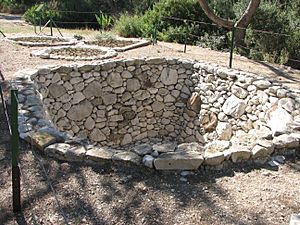
The Israelites appeared during the Early Iron Age (1200-1000 BCE). They first settled in the central hills, across the Jordan River, and in the northern Negev. Later, they moved to the Galilee. At the same time, the Philistines and other Sea Peoples settled along the coast. Raising animals remained important. Walled areas in villages were likely used for animal pens.
Building terraces on hills and plastered water cisterns allowed more farming. People dug storage pits and silos in the ground for grain. When Israel was a united kingdom, central cities were built to store food. More land in the northern Negev was farmed. The Gezer agricultural calendar, which lists the crops grown, comes from this time.
After the Israelite kingdom split, Jerusalem and other cities grew. They were supported by nearby villages and farms. Large food storage places and granaries were built, like in the city of Hazor. During the later Iron Age, olive oil and wine were made in large amounts. This was for trade and export, as well as for people to use locally.
The ancient Israelites relied on bread, wine, and olive oil as their main foods. The Bible often mentions these three together. Other writings and archaeological finds show they also ate other plant and animal products. The Bible lists seven main farm products, called the Seven Species: wheat, barley, figs, grapes, olives, pomegranates, and dates. The Bible also often describes Israel as a "land flowing with milk and honey."
The food stayed pretty consistent from early Israelite times until the Roman period. This was true even though new foods became available. For example, rice was introduced during the Persian era. During the Greek period, more spices became available through trade, especially for wealthy people. More Mediterranean fish were brought into cities. During the Roman period, sugar cane was introduced.
After the Second Temple
After the Second Temple was destroyed in 70 CE, the traditional foods of ancient Israel remained important for Jewish people. Bread, wine, and olive oil were seen as direct links to the main crops of ancient Israel: wheat, grapes, and olives. The Bible says these three foods show God's help for human needs. They especially represent the need for rain, which was vital for these crops.
The importance of wine, bread, and oil is shown by their use in Jewish religious ceremonies. Blessings are said over wine and bread for Shabbat and holiday meals. Olive oil is used to light Shabbat and festival candles.
What They Ate Daily
The everyday diet of an ordinary ancient Israelite was mostly bread, cooked grains, and beans. Bread was eaten with every meal. Vegetables were also important, usually cooked in stews. Israelites drank goat and sheep's milk when it was available in spring and summer. They also ate butter and cheese. Honey, from bees and dates, was also eaten.
Figs and grapes were the most common fruits. Dates, pomegranates, and other fruits and nuts were eaten less often. Wine was the most popular drink. Meat, usually goat and sheep, was rarely eaten by most Israelites. It was saved for special times like celebrations, festivals, or religious feasts. Wealthy people ate meat more often. Olives were mainly used for their oil, which was eaten raw and used for cooking. Wild animals, birds, eggs, and fish were also eaten if available.
Most food was eaten fresh and in season. Fruits and vegetables had to be eaten quickly before they spoiled. People often faced hunger or famine. Growing enough food needed hard work and good timing. The weather could make harvests unpredictable, so people stored as much food as possible. Grapes were made into raisins and wine. Olives were made into oil. Figs, beans, and lentils were dried. Grains were stored for use all year.
The Bible describes a meal Abigail brought to David's group. It included bread, wine, sheep meat, roasted grain, raisins, and fig cakes. This shows what an Israelite meal might look like.
Foods They Enjoyed
Grains and Bread
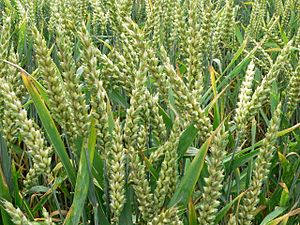
Grain products were the main food for ancient Israelites. Bread was the most important food. The Hebrew word for bread, lehem, also meant food in general. The Bible shows how important bread was, with many words for it and many proverbs about it. Bread was eaten at almost every meal. It is thought to have provided 50 to 70 percent of a person's daily calories. Until the end of the Israelite kingdom, bread was mostly made from barley flour. During the Second Temple period, wheat flour bread became more common.
Porridge and gruel were made from ground grain, water, salt, and butter. This mix was also used for cakes. Sometimes oil and fruits were added before baking.
Israelites grew both wheat and barley. These two grains are listed first among the Seven Species of Israel. Their importance is also seen in the barley harvest festival of Shavuot and the wheat harvest festival of Sukkot.
Rice was brought in during the early Second Temple period through contact with the Persians. By Roman times, rice was an important export. The Jerusalem Talmud even said rice in Israel was special.
Barley
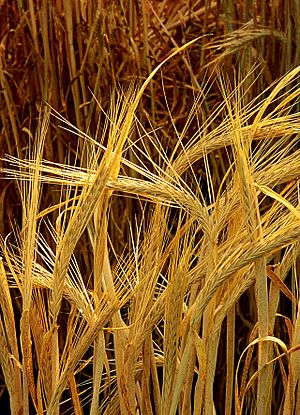
Barley was the most important grain during biblical times. This was recognized during Passover with an offering of barley flour from the new crop. Its importance is also shown because fields were measured by how much barley could be sown there.
Barley was popular because it grew earlier and could handle tougher conditions than wheat. It grew in areas with less rain and poorer soil, like the northern Negev and the hills. It produced a lot of grain and was resistant to insects. It could be planted without plowing, so it could grow on small plots. It also didn't need artificial watering. Barley ripened a month earlier than wheat. This meant it was available sooner to refill food supplies after winter. It also provided food security if the wheat crop failed.
Two types of barley were grown: two-rowed and six-rowed. Two-rowed barley was older and had a tough husk. Six-rowed barley was easier to thresh and store. Hulled barley was common in the Iron Age. Gruels made from it might have tasted gritty because of the tough outer layers.
Bread was mainly made from barley flour in the Iron Age. Barley was more common, cheaper, and could be made into bread without yeast. Wheat flour was seen as better quality. Barley bread was likely a simple mix of flour and water, shaped by hand, and baked. However, barley became less important as a staple food by the end of the Second Temple period. By the Talmudic era, it was mostly considered animal food.
Wheat
Emmer wheat was the most common type of wheat at first. It grew well in warm climates and resisted fungus. It produced a lot of grain with good gluten, making light bread. But emmer needed a lot of pounding or roasting to remove its husk.
During the Iron Age, durum wheat slowly replaced emmer. Durum grew well in rich soil in central and northern areas with enough rain. It produced more grain than emmer, and its grains were easier to separate from the chaff. This reduced the work needed for threshing and kept grains whole for longer storage.
However, durum is a hard grain. It was difficult to grind with early hand-held grindstones. The flour also needed to be sifted many times to get fine flour. So, durum was mainly used for porridges, or parboiled and dried. Barley flour continued to be used for bread until common or "bread" wheat replaced barley after the Greek conquest. This type of wheat became widespread during the Greek and Roman periods. Common wheat had more starch and gluten, making lighter breads than barley or durum wheat.
Preparing Grains
Technology for threshing, milling, and baking improved from the Iron Age to the end of the Second Temple period. In the early Iron Age, grain was threshed by beating it with sticks or by oxen walking on it. This often broke the kernels, making them spoil faster. The invention of the threshing-board, pulled by oxen, kept most kernels whole, improving storage time. Many threshing floors and boards have been found at ancient Israelite sites.
After separating grain from stalks, it was used in several ways. Unripe kernels were eaten fresh, especially in spring. Both unripe and ripe grain were roasted over fire for immediate use. Ripe wheat grains were also parboiled and dried, like modern bulgur, then made into porridge. Whole or cracked grain was used in stews and gruel. Most often, grains were ground into flour for bread.
Making Bread
Bread was the main food in biblical times. Making bread was a daily task.
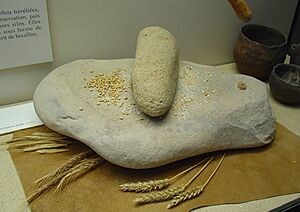
Bread-making started with grinding the grain. This was hard, time-consuming work, usually done by women. Each household stored its own grain. It took about three hours daily to make enough flour for a family of five. Early grinding used a pestle and mortar, or a stone quern. This quern had a large bottom stone for grain and a smooth top stone moved back and forth. This often left small bits of grit in the flour.
The use of the millstone became more common in the Iron Age, making flour production faster. Smaller versions for home use, like the rotary or beehive quern, appeared in the early Persian period. After grinding, flour was mixed with water and kneaded in a large trough. For wheat flour dough, a starter called seor was added. This starter was a small piece of old dough that helped the new dough rise and gave the bread a sourdough flavor.
Once ready, dough could be baked in different ways. Originally, dough was placed directly on hot stones of a fire or in a clay or iron pan. During the First Temple period, two types of ovens were used: the jar-oven and the pit-oven. The jar-oven was a large pottery container, heated from the inside. Dough was pressed on the outside to bake. The pit-oven was a clay-lined hole in the ground. Fuel was burned inside, then pushed aside, and loaves were baked on the hot surface. People also started putting a curved dome, first clay then metal, over the pit-oven. Flatbreads were cooked on this dome.
The Persians introduced a clay oven called a tanur (like an Indian tandoor). It had a bottom opening for the fire. Bread was placed on the inner wall of the top part to bake from the heat and ashes. This method was used by Yemenite Jews until modern times. Remains of clay ovens and bread trays have been found. All these methods made thin loaves. So, people would break bread instead of cutting it. The bread was soft and flexible, used for dipping in gravies and juices.
The Romans brought in a large, wood-burning, stone-lined oven called a furn. This was a big step forward for baking. It allowed for much thicker loaves.
Many types of bread were made. Most common were unleavened flat loaves called ugah or kikkar. Another type was a thin wafer, a rakik. A thicker loaf, hallah, was made with the best flour, often for religious uses.
Bread was sometimes made richer by adding flour from beans. The Mishna mentions bread dough made with fruit juice instead of water. The sugar in the juice helped the bread rise and made it sweet. Israelites also sometimes added fennel and cumin for flavor. They dipped their bread in vinegar, olive oil, or sesame oil for extra taste.
Legumes
After grains, legumes like lentils, broad beans, chickpeas, and peas were a main part of the diet. They were the main source of protein, as meat was rarely eaten.
Broad beans, chickpeas, and lentils are the only legumes mentioned in the Bible. But lentils, broad beans, chickpeas, fenugreek, field peas, and bitter vetch have been found at Iron Age Israelite sites. By Roman times, legumes were often mentioned in other texts. They were a key part of the "wife’s food basket" in the Mishna. It's estimated that legumes provided 17% of daily calories then.
Lentils were the most important legume. They were used for porridges and soups. Fried lentil cakes called ashishim were also made. King David is said to have given these out when the Ark of the Covenant came to Jerusalem. These ashishim were honey-dipped pancakes made from crushed red lentils and sesame seeds.
Lentil or bean stews were common. They were cooked with onion, garlic, and leeks for flavor. Fresh legumes were roasted, or dried and stored. Then they were cooked in soup or stew. The Bible mentions roasted legumes. It also tells how Jacob made bread and lentil pottage for Esau.
Vegetables
Vegetables are not often found in old archaeological sites. It's hard to know how big a role they played. This is because plant foods were often eaten raw or simply boiled. This didn't require special tools that would leave traces.
Vegetables are also not mentioned often in old writings. When the Bible does mention them, it's a mixed view. Sometimes they are seen as a special treat. But more often, they were not highly valued.
Vegetables might have been more important for the very rich and the very poor. The rich could afford to grow them. The poor depended on gathering them in the wild to add to their small food supplies. More people might have gathered wild plants during times of famine.
Common vegetables included leeks, garlic, onions, black radishes, melons, and watermelons. Other vegetables were less important. Wild greens and root plants were usually not grown. They were gathered seasonally when they grew wild. Leafy plants included dandelion greens and young orach leaves.
Leeks, onions, and garlic were eaten cooked in stews. They were also eaten raw with bread. Their popularity might be shown by the Bible saying Israelites missed them after leaving Egypt.
Gourds and melons were eaten raw or with vinegar. Black radishes were also eaten raw in autumn and winter. The Talmud mentions using radish seeds for oil. It also said eating radishes was good for health.
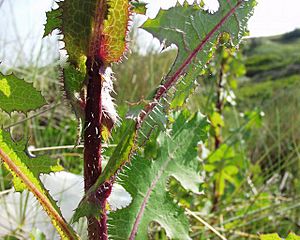
Wild herbs were collected and eaten raw or cooked. These included garden rocket and mallow. Both leaf chicory and endive were also eaten.
Wild lettuce, called chazeret, was a leafy herb with prickly, red-tinged leaves. It became bitter as it grew older. It was grown from about 800 BC. Sweeter head-lettuce was only developed and brought in by the Romans.
Bitter herbs eaten at the Passover sacrifice with unleavened bread were called merorim. Chazeret is listed in the Mishna as the best bitter herb for this Passover ritual. Other bitter herbs included chicory or endive, horehound, reichardia or eryngo, and wormwood.
Mushrooms, especially the Boletus type, were gathered in many areas. They were plentiful after heavy rain. The Talmud mentions mushrooms as a dessert at the Passover seder.
Sesame seeds were used to make oil. They were eaten dry or added to dishes like stews for flavor. The leftover parts after pressing the oil were eaten as a cake. Sesame is not in the Bible. But the Mishna says sesame oil was good for lighting Sabbath lights. The oil was also used for frying.
Fruit
Fruit was an important food source for Israelites. Grapes, olives, and figs were especially important. Grapes were mostly grown for wine. Some were eaten fresh during harvest or dried as raisins. Olives were grown only for their oil until Roman times. Other fruits eaten were dates, pomegranates, and sycamore figs.
Ancient Israelites built terraces on hills for growing crops, including fruit trees. All trees, except the olive, produced fruit that could be eaten fresh or juiced when in season. Fruit was also processed for later use. Fruits with high sugar were fermented to make alcoholic drinks, mostly wine from grapes. Fruit was also boiled down into a thick, sweet syrup, called dvash (honey) in the Bible. Grapes, figs, dates, and apricots were dried and preserved. They were eaten individually, strung on a string, or pressed into cakes. Dried fruit provided good energy, so it was prepared for journeys.
Olives and Olive Oil
The olive is one of the biblical Seven Species. It is also one of the three main foods in Israelite Mediterranean cooking. Olive oil was used for food, cooking, lighting, offerings, and anointing priests or kings.
The olive tree grew well in the climate and soil of the Israelite highlands. A large part of the hill country was used for olive trees. They were one of ancient Israel’s most important natural resources. Olive oil was more useful and lasted longer than oil from other plants, like sesame. It was also thought to taste the best.
Olives were used to make oil from the Bronze Age. But it was only in the Roman period that methods were introduced to cure olives in lye and then salt water. This removed their natural bitterness and made them edible.
Olives were harvested in late summer. They were processed for oil by crushing them, pressing the pulp, and separating the oil. In the early Iron Age, this was done by treading olives in rock basins, or with a mortar and stone on a flat slab. In the later Iron Age, the beam press allowed for large-scale processing.
Many ancient olive presses have been found. This shows that olive oil production was very developed in ancient Israel. A large oil production center from the 7th century BC was found at Ekron, a Philistine city. It has over a hundred large olive presses. This shows that ancient Israel was a major producer of olive oil for its people and for trade with other parts of the ancient Near East, like Egypt and Mesopotamia. Besides large-scale production, presses were also found in ordinary houses, meaning people made oil at home too.
Archaeological finds at Masada and other sites show that the most common olive types were the local Nabali and Souri. In Roman times, other olive types were brought from Syria and Egypt.
There is also written information about olive oil. The Bible describes its use in sacrifices. These "recipes" likely show everyday uses of oil for cooking and frying. Olive oil was mixed with flour to make bread. It was also noted as a valuable food product. Olive oil is also mentioned in ancient writings found at Samaria and Arad.
How much olive oil people ate depended on their social class. It was less available to the poor. But it may have become more common later as production improved. By early Roman times, the Mishna says it was one of four essential foods a husband had to give his wife. It's estimated to have provided about 11 percent of the total calories in the "food basket" described then.
Grapes
Grapes are another of the biblical Seven Species. They were mainly used to make wine. But they were also eaten fresh and dried. Grapes were dried in the sun to make raisins, which could be stored for a long time. Raisins were also pressed into cakes and dried.
Grapes were also used to make a thick, honey-like liquid called grape honey. This was used as a sweetener. Grape honey was made by treading grapes in vats. Instead of fermenting, the liquid was boiled to remove water, leaving a thick syrup.
Figs
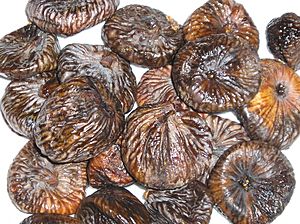
Figs were an important food source. Figs were grown all over the land of Israel. Fresh or dried figs were part of the daily diet. A common way to prepare dried figs was to chop them and press them into a cake.
Figs are one of the biblical Seven Species and are often mentioned in the Bible. Remains of dried figs have been found from as early as the Neolithic period in Gezer, Israel, and Gilgal in the Jordan Valley.
The fig tree grew well in the hill country and produced two crops a season. Early figs were a sweet treat and eaten fresh. Later figs were often dried and strung into a chain. Or they were pressed into hard round or square cakes called develah. These were stored as a main winter food. The blocks of dried fig were sliced and eaten like bread. The Mishna mentions figs as part of the "wife’s food basket." They are estimated to have provided 16% of the total calories in that basket.
Dates
Dates were eaten fresh or dried. But they were mostly boiled into a thick, long-lasting syrup called "date honey." This was used as a sweetener. This syrup was made by soaking dates in water until they broke apart. Then the liquid was boiled down into a thick syrup. The "honey" in the Bible's "land flowing with milk and honey" likely refers to date honey.
Fresh, ripe dates were available from mid to late summer. Some were sun-dried and pressed into blocks to dry completely. These were used throughout the year, especially for travelers. Dates were also fermented into one of the "strong drinks" mentioned in the Bible.
The date palm needed a hot, dry climate. It mostly grew and produced fruit in the Jordan Rift Valley. In these dry areas, dates were sometimes the only plant food available and a main part of the diet. But they were less important elsewhere.
Pomegranates
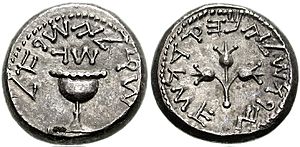
Pomegranates were usually eaten fresh. Sometimes they were used to make juice or wine. They were also sun-dried for use when fresh fruit was out of season. They probably played a small role in Israelite cooking. But they were important symbols. They decorated the high priest's robe and Temple pillars. They were also on coins. The Bible lists them as one of the Seven Species of Israel.
Other Fruits and Nuts
Sycamore figs, carobs, mulberries, and possibly apples were also eaten. These fruits were usually not grown on farms. They were picked in the wild when in season. The sycamore fig was common in warmer parts of Israel. It was grown mainly for its wood. But it also gave a steady supply of small figs, mostly eaten by the poor.
Other native fruit trees included the carob, popular for its sweet taste, and the black mulberry. The word tapuah, which means "apple" today, is in the Bible. But it's unclear if it meant another fruit, like an apricot or quince.
Almonds, walnuts, and pistachios were eaten and are mentioned in the Bible. Almonds were common in the region from ancient times. The Bible mentions almonds and pistachios as "choice fruits of the land" sent by Jacob as a gift. Almonds and pistachios were probably eaten mainly by the wealthy. Walnuts came to Israel from Mesopotamia by at least 2000 BCE. They are mentioned once in the Bible. Walnuts became common during the Second Temple period. The Hebrew word for walnut, egoz, became the general word for nut then.
Wine and Other Drinks
Israelites usually drank water from wells, cisterns, or rivers. They also drank milk, often as sour milk, thin yogurt, or whey, when available in spring and summer. They drank fresh fruit juices in season. The most preferred drink was wine. Some beer might have been made too. Wine was an important part of the diet. It provided calories, sugar, and iron. Making wine was also a good way to store fruit juices for a long time. Wine was usually made from grapes for daily use and for religious rituals. Less often, wine was made from pomegranates and dates.
Wine
The Mediterranean climate and soil in the mountainous areas were good for growing grapes. Both old archaeological finds and written records show that grapes were widely grown in ancient Israel. Wine drinking was very popular. The amount of wine produced and the many Bible references suggest wine was the main alcoholic drink. Based on wine production sites, people might have drunk about one liter of wine per person per day.
Many rock-cut winepresses and vats from biblical times have been found. One example at Gibeon has a large surface for treading grapes and collecting vats. Finds at Ashkelon and Gibeon show large-scale wine production in the 8th and 7th centuries BC. This likely supplied the Assyrian and Babylonian empires, as well as local people. Vineyards are mentioned many times in the Bible, with details on how to set up a vineyard and types of vines. The Bible mentions several types of wine. An ancient writing from Arad also mentions wine sent to soldiers.
Another sign of wine's importance in ancient Israel is that Hebrew has many words for different stages of vines, grape types, and wines. The word yayin was a general word for wine. It also meant wine in its first year after fermentation. Before that, it was called tirosh. The type of wine depended on the grapes, fermentation time, and how old the wine was.
The often rough taste of ancient wine was adjusted to make it better. Spices were added directly to wine to improve its smell. Other things like honey, pepper, herbs, lime, resin, or seawater were added to improve flavor or hide bad taste. Wine was also sweetened with grape juice syrup. Sometimes, the winepress was rubbed with wood resin to give the wine a pine smell. Wine could also be added to drinking water to improve taste, especially in late summer when rainwater had been in cisterns for months. This also helped lower bacteria in the water.
After the grape harvest in mid-summer, most grapes went to wine presses to get their juice for winemaking. Once fermented, wine was put into wineskins or large clay jars for storage. Israelite jars were usually tall with big handles and little decoration. The handles often had the city name, winemaker's stamp, and sometimes the year. These jars allowed long-term storage, especially in caves or cool cellars. Glass bottles for wine only appeared in the 1st century AD with the Romans.
The inside of the jars was often coated with a resin, like from the terebinth tree. This gave the wine a pine flavor and smell. Before sealing the jars with pitch, they were filled completely. Often, a thin layer of olive oil was put on top to prevent spoilage from air.
During the Greek period, winemaking changed. Ripe grapes were first dried to make the sugars more concentrated. This produced a much sweeter wine with higher alcohol content that needed to be mixed with water to be drinkable. Before this, watered-down wine was not liked. But by the time of the Talmud, wine that didn't need water was considered not good to drink.
Beer
Beer, made from barley, was another alcoholic drink common in the ancient Near East. Beer was the main drink in ancient Egypt and Mesopotamia. So, it's likely beer was also known in Israel, which is between them. The biblical word sekhar might mean beer or alcoholic drinks in general.
Making bread and beer were closely linked. Barley was a key ingredient for both. Most tools for beer, like mortars and grinding stones, were also used for bread. So, archaeological evidence just for beer making is rare. Earlier, it seemed ancient Israelites didn't drink beer often. More recently, Iron-Age sites in Israel have found beer jugs, bottles, strainers, and stoppers. These show that Israelites did drink beer. Still, the widespread growing of grapes, mainly for wine, suggests wine drinking was much more common than beer.
Meat
Israelites usually ate meat from domesticated goats and sheep. Goat meat was the most common. Fat-tailed sheep were the main type of sheep. But sheep were more valued than goats, so they were eaten less often. The fat from the tail was considered a special treat.
Beef and venison were mainly eaten by wealthy people. Fattened calves provided veal for the rich.
For most people, meat was eaten only a few times a year. This was when animals were slaughtered for major festivals, tribal meetings, celebrations like weddings, or for important guests. Only at the king's table was meat served daily, according to the Bible. Most meat came from farm animals. But meat from hunted animals was also sometimes available. This is shown in the story of Isaac and Esau, some Bible lists, and archaeological evidence. Remains of gazelle, red deer, and fallow deer are most commonly found.
Archaeological finds from an Iron-Age market in Ashkelon show that wild game was also sold. This was for those who couldn't hunt themselves. However, wild animal meat was more common during hard economic times. It was also more common in northern areas, where forests provided homes for more wild animals.
Meat was prepared in several ways. The most common was cooking it with water as a broth or stew. Meat stewed with onions, garlic, and leeks, flavored with cumin and coriander, is described on ancient Babylonian tablets. It was likely prepared similarly in ancient Israel. Stewed meat was considered good enough for honored guests. A less common way was to roast meat over an open fire. This was especially done for the Passover lamb. For long-term storage, meat was smoked, dried, or salted.
Poultry and Eggs
Israelites ate domesticated birds like pigeons, turtledoves, ducks, and geese. They also ate wild birds like quail and partridge. Finds from archaeological digs in Jerusalem and other Iron-Age sites show domestic birds were available, but not eaten much. Pigeons and turtledoves in Bible sacrifice lists suggest they were raised at home. Remains of dovecotes from Greek and Roman times confirm this. Bible references and archaeological evidence also show wild birds were hunted and eaten.
Turtledoves were present from about April to October. Rock pigeons were available all year. Pigeons seem to have been domesticated in Sumeria and Canaan around 2000 BC. They remained the main poultry in ancient Israel until the end of the Second Temple period. However, to avoid disease, pigeons could only be raised in small numbers. So they were quite costly and not a regular part of the diet.
Geese, first domesticated in ancient Egypt, were raised in ancient Israel. They were likely the "fattened fowl" on King Solomon’s table. Goose breeding is also discussed in the Mishna. Like other animals, birds were fattened for special occasions and for the wealthy.
It's not clear when chicken became part of the diet. Some chicken remains are found at Iron-Age sites. But these were likely from roosters used for fighting. Chickens became common around 200 BC. During the Roman period, chickens became an important food. The Talmud called them "the choicest of birds." By Roman times, pigeons and chickens were the main poultry.
Until chickens were domesticated, eggs were limited and considered a special treat. The most common birds—turtledoves and pigeons—were raised for meat, not for their very small eggs. Bible references to eggs are only about gathering them from the wild. Eggs seem to have been used more for food only after chickens became common. They were widely eaten by Roman times.
Fish
Israelites ate various fresh and saltwater fish. This is known from archaeological and written evidence. Remains of freshwater fish from the Yarkon and Jordan rivers and the Sea of Galilee have been found. These include St. Peter’s fish and mouthbreeders. Saltwater fish found include sea bream, grouper, meager, and gray mullet. Most came from the Mediterranean Sea. But in the later Iron Age, some were from the Red Sea. The Torah forbids eating fish without fins or scales. However, archaeological evidence shows many Israelites did not follow these rules. They ate non-kosher seafood, mostly catfish, but also shark, eel, and ray. Strict religious rules about seafood began to be followed more closely in the first century CE.
Fishermen supplied fish to towns away from the coast. Fish remains, like bones and scales, have been found at many inland sites. To preserve fish for transport, they were smoked or dried and salted. Merchants also imported fish, sometimes from as far as Egypt. Remains of Nile Perch from Egypt have been found. These must have been smoked or dried before being traded. Merchants shipped fish to Jerusalem. There was clearly a big trade in fish. One of Jerusalem's gates was called the Fish Gate, named for a nearby fish market.
It's unclear how big a role fish played in their cooking. But it seems fish became more available during the Israelite and Judean kingdoms. Fish products were salted and dried and sent long distances. However, even in later Persian, Greek, and Roman times, preserving and transporting fish was costly. So, only wealthier people in highland towns and cities could afford it. Or those who lived near the coast, where it was cheaper. In the Galilee, small-scale fishing was a basic part of the farming economy.
Dairy Foods
Goats and, less so, sheep provided milk for part of the year. Milk and dairy products were an important food source. Dairy products are mentioned in the Bible. The Land of Israel is repeatedly described as "a land flowing with milk and honey."
Fresh milk could not be stored long without spoiling. People usually drank thick sour milk called laban. This was because Israelites stored milk in skin containers, where it curdled quickly.
Milk had to be processed to preserve it. This was done by churning it, using a goatskin or clay container. This separated the butterfat from the whey. The butterfat was boiled and then cooled to make clarified butter. This could be stored for a long time. Clarified butter was mainly used for cooking and frying. Butter churns have been found at Beersheba, dating from the 4th century BC, and other ancient Israelite sites.
Goat milk and sheep's milk cheeses were the most common types. Soft cheese was made using cloth bags filled with soured milk. The thin liquid drained through the cloth, leaving soft cheese in the bag. Hard cheese was made from fermented soured milk. Milk was poured into special molds where it curdled. Then it was hardened by drying in the sun or by heating small cheese molds with holes for draining the whey. Cheese is not often mentioned in the Bible. But in one story, David is sent to take cheese as a gift to the army commander. The Mishna and Talmud mention using sap from fruit trees, like figs, to harden cheese. Using fig sap instead of animal enzymes to make cheese also followed the rule against mixing meat and milk.
Honey
Fruit syrup called dvash was the main sweetener. It was most often made from dates. It was not until Talmudic times that the word "dvash" generally meant bee honey. The biblical term dvash usually meant thick syrup from grapes, figs, or dates. This syrup was similar to the date syrup, or halek, that many Jews still use today.
The biblical references to "honey from the crag" or "honey from the rock" could mean fig honey, as fig trees grew in rocky areas. Or it could mean honey collected from wild bees, which made nests in these places. The Bible mentions bee honey only a few times. For example, Samson eats honey from a lion's carcass. Jonathan eats honey from a honeycomb. These refer to wild honey.
However, the oldest archaeological find about beekeeping is an apiary from about 900 BC at Rehov. This was a Bronze-Age and Iron-Age site in the Jordan Valley. The hives, made of straw and clay, could have held over a million bees. This shows honey was produced on a large scale. It's likely the people of Tel Rehov brought bees from Anatolia. These bees were less aggressive than local bees and produced more honey. It's also possible that bee domestication for honey came from Egypt during the Iron Age. So, honey from domesticated bees was available from late in the Iron Age.
Seasonings
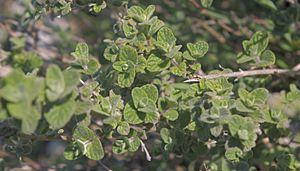
The most common and important seasoning was salt. Its importance is shown by how often it's in the Bible. Its use was required with most sacrifices. Salt came from the Mediterranean Sea or the Dead Sea. It was made by evaporating seawater from natural and man-made drying pans along the Mediterranean coast. It was also mined from salt deposits, like at Sodom near the Dead Sea. Salt had to be transported, so most communities bought it.
Food was also flavored with plants. Most were native to the region and either grown or gathered wild. A few spices were imported. Garlic, onions, and possibly fenugreek were used to season cooked foods. They were also eaten as vegetables. Herbs and spices included capers, coriander, cumin, black cumin, dill, dwarf chicory, hyssop, marjoram, mint, black mustard, reichardia, saffron, and thyme. Some seasonings were imported, like myrrh, galbanum, saffron, and cinnamon. But their high cost meant they weren't widely used. Spices for special feasts were imported by the wealthy and royalty from Arabia and India. These were highly valued. They included various types of pepper and ginger.
Another seasoning was vinegar. It was made by extra fermentation of new wine. It was used for seasoning foods, pickling vegetables, and for medicine.
Storing and Preparing Food
Storing water and food was vital for survival. Especially important was storing enough food from one harvest to the next. To protect grain from dampness and pests, underground granaries were used for large amounts of grain. Families also stored grain, wine, and oil in large pottery jars in their homes. If well protected, wheat, barley, legumes, and nuts could be kept for long periods. Rainwater from roofs and courtyards was collected in cisterns to add to natural sources like springs and wells.
Fermentation, oil extraction, and drying were all ways to turn food into products that could be stored. Feeding crops to animals was also a way of "storage on the hoof." Animals converted the food into meat or milk.
Food was cooked in clay pots. These pots were placed on horseshoe-shaped earthenware stands. The fire was lit through the opening under the pot. Or pots were hung above the fire from tripods.
Cooked food included soups and stews, which were a mix of meat and vegetables. Beans and lentils were likely cooked several times a week. However, vegetables like melons, garlic, leek, and onions were also eaten uncooked.
Meals in Ancient Israel
Meals eaten by the Israelites were of two types: daily meals and festive or ritual meals.
Daily Meals
Daily meals were prepared by women. Families usually ate two meals a day, either at home or in the field. The first meal was in the late morning, a break from work. It might include roasted grain, olives, figs or other fruit, bread dipped in olive oil or vinegar, or bread with garlic, onions, or black radishes for flavor. Water or wine was also drunk. A description in the Book of Ruth shows this kind of meal: harvest workers eat bread dipped in vinegar and roasted grain. Farm workers, who were most of the population, also ate a light meal early in the morning before going to work.
The second meal was the main meal of the day and was eaten in the evening. Besides bread, it usually included soup or a stew of vegetables or legumes. This was served in a common pot where everyone dipped their bread. Sometimes, cheese and fresh fruits like figs and melon were served when in season. Dried fruits were also eaten. Water, wine, and milk could go with the meal.
Small bowls were used for both eating and drinking. Small jugs held things like olive oil, vinegar, and sweeteners. Wide-mouthed pitchers held water and milk. Spouted decanters with narrow, ridged necks and built-in strainers held wine.
Festive Meals and Feasts
Festive meals were held for important events, to entertain special guests, or as religious sacrifices. Both men and women prepared these meals. Meat was always served. Many people shared the meal so there would be no leftovers.
Special feasts and banquets in ancient Israel were important for building friendships and showing status. They were used for business deals, asking for divine help, showing thanks to a deity, or teaching social lessons. These meals were meaningful because of the occasion. They were also a time for fun and enjoyment.
Festive meals happened only sometimes, but they are recorded in the Bible and other writings. Many Bible stories take place during a meal. Examples include Abraham preparing food for his visitors, Jacob making stew for his father Isaac, and the Passover meal.
In the story of Abraham hosting three visitors, he offers cakes, a well-prepared young calf, curds, and milk. This meal is similar to an earlier meal described in the story of Sinuhe, an Egyptian nobleman. Sinuhe lived in Canaan around 1900 BCE. His meal included bread, wine, cooked meat, roast fowl, and dairy products.
One key difference for the wealthy was eating meat more often. A description of food for King Solomon's kitchen shows this: "Solomon's daily provisions consisted of 30 kor of fine flour and 60 kor of flour, 10 fat oxen, 20 pasture-fed oxen, and 100 sheep and goats, in addition to deer and gazelles, roebucks and fattened geese." This shows what was possible for those with money. It indicates enough food for thousands of people.
Another example of a grand meal is the opening of the Temple by Solomon. Similar meals are described for Hezekiah's temple dedication and Passover celebration.
Unlike the simple daily food of ordinary people, the food at royal courts in the ancient Near East was fancy. It's believed that dishes served at King Solomon's table were also elaborate. King David had officials in charge of wine cellars, olive stores, cattle, and olive and fig trees. The royal kitchen was very organized.
The kings of Israel showed great hospitality, like other kings of the ancient Near East who held grand banquets. Solomon’s royal table offered such a variety of foods that the Queen of Sheba was amazed. She said reports of his wealth did not match what she saw. Royal entertainment in Israel included music, many guests, and likely many servers and cupbearers.
Feasts and banquets were important social and political tools throughout Israel’s history. Especially in the early days of the Israelite kingdom, an invitation to the king’s table was important for gaining political support. It also showed high social status.
Regular meals also became ways to show common identity, social unity, and celebration. By the Roman period, Jewish communities gathered at banquets for food and company. The weekly Sabbath meal was a time for families to gather and enjoy food and company.
Hospitality
Hospitality was a basic custom in Israelite society. Serving food was a key part of hosting guests. Also, in ancient Israel, people believed God had freed Israel from slavery. This led to a social rule and religious command to care for guests and strangers as a way of showing thanks.
The importance of hospitality can be seen in many Bible stories. These include Abraham hosting messengers, Gideon's call to leadership, the woman from Zarephath hosting Prophet Elijah, and the Shunammite woman hosting Elisha. Also, David hosting Mephiboshet, and Hezekiah inviting people to celebrate Passover in Jerusalem.
Meals with important guests were special occasions, and meat was served. The order in which guests were served showed their social status. The choice of meat and dishes showed how important the occasion was. The Bible shows this when Samuel hosts Saul. Saul is seated at the head of the hall and served first with a special portion of meat.
Certain parts of the animal, like the breast and right thigh, were considered the best. They were saved for the most honored guests. Guests were always served before family members. The host would also sit with the guests to encourage them to eat and meet their needs, as Abraham did for his visitors.
Sacrificial Meals
Sacrificial meals were eaten when part of a sacrifice was set aside for the priest or for the ordinary Israelite who brought the offering. This person could eat a portion with their family at a festive meal. The offerings considered "most holy" were eaten by male priests in the Temple sanctuary court. This meal was part of the priest’s duties. Other offerings could be eaten by priests with their families in any ritually clean place. The ordinary Israelite had to eat their share within a set time, with their family, guests, and any Levites and strangers they invited.
Depending on the type of sacrifice, animals offered could be a lamb, kid, goat, ram, calf, bull, or cow. Bird offerings were doves and turtledoves (pigeons). Of these, the guilt offering and the communal peace offering were eaten only by male priests. Other offerings, like the Firstborn offering, could be eaten by priests and their households. For the personal peace offering and Thanksgiving offering, the breast and thigh meat were eaten by priests and their households. The rest was eaten by ordinary Israelites. The Tithe offering could be eaten by anyone. The Passover offering was eaten by all who had bought a share in the sacrifice.
Meal offerings, called mincha, were mainly flour. They were either fully or partly burned on the altar. Those not fully burned were eaten by the priests. Some mincha offerings were fried or baked before being offered. Types of mincha included fine flour mixed with oil, flour mixed with oil and fried, bread called challot mixed with oil and baked in an oven, and wafers smeared with oil baked in an oven.
There were also baked goods, all made of wheat flour and baked in an oven, which were not burned on the altar. These were the twelve unleavened showbreads, eaten by priests after being displayed. Two loaves of leavened bread prepared for the festival of Shavuot were eaten by the priests. Thanksgiving breads included leavened bread, unleavened bread, unleavened wafers, and scalded loaves. One of each kind was given to the priests, and the rest eaten by the owner and guests. Unleavened loaves and wafers came with the Nazirite’s sacrificial ram. One of each kind was given to the priests, and the rest eaten by the Nazirite and guests.
Whole extended families or clans also took part in sacrifices offered on occasions like the New Moon. This was called a "sacrifice of days" or a kinship sacrifice. In early Israelite times, before sacrifices were only done at the Temple, these were offered in various places. David is described leaving Saul’s table to join his family in Bethlehem. Elkanah went to Shiloh to join his household in the yearly sacrifice.
Perhaps the oldest and most important feast celebrated by Jews is Passover. The original feast, from the Exodus story, included a sacrificial lamb, bitter herbs, and unleavened bread eaten by each family at home. Under the Israelite monarchy, with the Temple in Jerusalem, Passover sacrifice and celebration became centralized as one of the three pilgrimage festivals. Families who could travel to Jerusalem ate the Passover meal together there. Those who could not make the pilgrimage celebrated the holiday with a special meal and observed the Feast of Unleavened Bread.
Forbidden Foods
The Israelite diet was also shaped by religious rules that banned certain foods. This included which animals could be eaten and how food was prepared. So, Israelite cooking was different from their neighbors'. For example, ancient Mesopotamian recipes used animal blood and milk in meat stews. Ancient Israelites would have avoided this.
Only animals specifically killed for food or sacrifice could be eaten. The Bible lists which animals, birds, and fish were allowed or forbidden. Animal bones found by archaeologists mostly support this, with some exceptions. For Israelites, food was a way to define themselves. While we don't know how strictly dietary laws were followed, self-definition likely explains why certain animals were forbidden. The rule against eating pigs may have started in the early Iron Age.
Archaeological evidence shows that eating pork, though limited, was higher in the early Iron Age. But it mostly disappeared in the later Iron Age. Sites in the highlands and coastal plains show low pig use in the early Iron Age. But on the coastal plain, like Ekron, more pig was eaten. This is usually linked to the Philistines. However, even at Philistine sites, pig remains were a small part of the bones found, and they decreased after the first settlement period. This might have been because the environment wasn't good for raising pigs.
At archaeological digs at Mount Ebal in Samaria, from right after the Israelite conquest, only bones from allowed animals were found. These included cattle, sheep, goats, and deer.
Some rules were not about the food source but how it was prepared. For example, the rule against boiling a young goat in its mother’s milk is mentioned three times in the Bible. Milk and its products were used in pagan worship in the Near East for gods and kings. Milk was linked to reproduction. So, a goat kid would be cooked in its mother's milk. The Israelite practice was to avoid actions similar to those done by the Canaanites as part of their religious worship.
Israelites believed an animal’s blood represented its life. So, its blood should not be eaten. The blood of a slaughtered animal was drained before the meat was used. The blood itself was not used for cooking or drinking.
There are no Bible lists of forbidden plants. So, it's assumed any plant or fruit was allowed as food. Their use was limited only by taste, or if they were poisonous. And by following religious rules like tithing.


